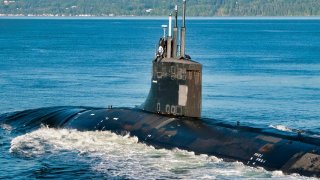Seawolf-Class: The U.S. Navy's Great Mistake Can't Ever Be Fixed
The U.S. Navy's Seawolf-class submarines are among the most advanced undersea vessels, designed to counter Soviet threats and equipped with powerful Mark 48 torpedoes, Harpoon anti-ship missiles, and Tomahawk cruise missiles. However, only three were built due to their high cost, with the Navy instead prioritizing aircraft carriers.
Summary and Key Points: The U.S. Navy's Seawolf-class submarines are among the most advanced undersea vessels, designed to counter Soviet threats and equipped with powerful Mark 48 torpedoes, Harpoon anti-ship missiles, and Tomahawk cruise missiles. However, only three were built due to their high cost, with the Navy instead prioritizing aircraft carriers.
-Critics argue this was a shortsighted decision, especially given the growing anti-access/area-denial capabilities of China and Russia, which could render carriers less effective.
-With only two operational Seawolf submarines currently available, the U.S. may find itself at a strategic disadvantage in future conflicts.
Seawolf-Class Submarines: America's Missed Naval Revolution?
The U.S. Navy’s Seawolf-class submarines are widely considered to be the best vessels to ever “run silent, run deep.” At $3.5 billion per sub, these undersea demons keep Russian and Chinese war planners up at night.
Seawolf-class submarines are usually equipped with powerful heavyweight 533-mm Mark 48 torpedoes. They are armed with Harpoon anti-ship missiles as well, and the platform can fire Tomahawk cruise missiles at targets on land. Seawolf-class subs can cruise underwater at an astonishing 35 knots, or 20 knots when rigged for silent running.
Designed in 1983 to respond to Soviet attack submarines such as the ubiquitous Akula class, the Seawolf class was intended to replace aging Los Angeles-class attack submarines. Washington planned to build and deploy around 30 of these technological marvels over the course of a decade.
After 41 years of existence, however, only three Seawolf-class subs are in service.
The reason there are so few of these lethal submarines is their high cost per unit. Back in the 1990s, the Seawolf class accounted for about 25% of the U.S. Navy’s entire construction budget. Of course, given the nightmare fuel that the Seawolf-class serves up to America’s two biggest geostrategic challengers — Russia and China — it strains credulity that either Congress or the Pentagon would believe that the money could have been better spent.
Alas, they did think that.
The Navy’s Wastefulness is Unbelievable
Rather than investing in the dynamic Seawolf class, the U.S. government opted instead to invest in the Navy’s lavishly funded aircraft carrier program. At an initial cost of $13 billion per ship, and an additional $700 million per year, America’s Navy decided to build the Ford-class aircraft carrier. For the same cost, at $3.5 billion per unit, the Navy could have built four more Seawolf-class submarines.
Because of the advent and refinement of the anti-access/area-denial capabilities of America’s main strategic rivals, all of the investment into new aircraft carriers is basically a waste. If China or Russia can seriously threaten the safety of American aircraft carriers, Washington will keep those assets far removed from any war zone, creating a hulking gap in its power-projection capabilities.
Had the Navy been smarter and simply invested those funds in the far more useful Seawolf class, they could afford to risk losing some of these assets in combat. As it stands now, however, with just three units in the fleet and no others coming down the pipeline, the Seawolf class could essentially be made extinct by damage in combat against a great power rival.
Only Two Operational Seawolf Subs
The USS Connecticut is one of the three Seawolf-class subs in the fleet. In 2021, the submarine was patrolling the South China Sea, operating very near China’s sophisticated submarine base on Hainan Island. While performing its mission in international waters, the submarine crashed into an underwater mountain and suffered nearly catastrophic damage. It limped back to port and has been undergoing a refit. The Connecticut is not expected to return to service for at least another year.
That means that the U.S. fleet has only two Seawolf-class subs right now.
One of the Seawolf-class submarines, the USS Jimmy Carter, was selected to be used for special operations missions. It was extended to 100 feet long in 2005. The Jimmy Carter’s capabilities are noteworthy, even for a submarine of this class. Should China successfully invade Taiwan, one could see the Jimmy Carter being covertly deployed to drop Special Forces operators and weapons behind enemy lines in occupied Taiwan, where they would support the inevitable Taiwanese insurgency against the Chinese invaders.

Seawolf-Class Submarine: Wasted Assets
But that is one sub. Imagine if the Pentagon had followed through on its plan for a minimum of 30 Seawolf systems. The Seawolf-class submarine is probably far more relevant to any potential war with China or Russia than the entire U.S. aircraft carrier fleet. Building up this class of submarine is probably impossible now – America’s declining defense industrial base cannot support the demand. (The shoddy state of American shipyards is one of the reasons the Connecticut is taking so long to repair)
The Navy missed the boat on the Seawolf-class submarine revolution. It is now about to pay the ultimate price for its shortsightedness when it favored the interests of big defense contractors and their preference for carriers over the national interest in shifting the Navy’s focus toward submarines.
Author Experience and Expertise: Brandon J. Weichert
Brandon J. Weichert, a National Interest national security analyst, is a former Congressional staffer and geopolitical analyst who is a contributor at The Washington Times, the Asia Times, and The-Pipeline. He is the author of Winning Space: How America Remains a Superpower, Biohacked: China’s Race to Control Life, and The Shadow War: Iran’s Quest for Supremacy. His next book, A Disaster of Our Own Making: How the West Lost Ukraine, is due October 22 from Encounter Books. Weichert can be followed via Twitter @WeTheBrandon.
All images are Creative Commons or Shutterstock.
From the Vault
Russia Freaked Out: Why the U.S. Navy 'Unretired' the Iowa-Class Battleships
Battleship vs. Battlecruiser: Iowa-Class vs. Russia's Kirov-Class (Who Wins?)


